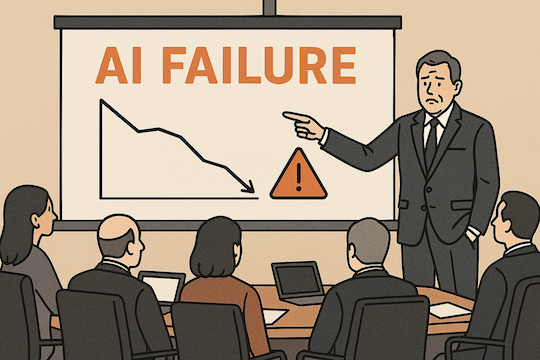
Artificial Intelligence has quickly gone from the stuff of sci-fi to the boardroom’s favorite buzzword. Leaders are scrambling to bolt AI onto their organizations, often with the hope that it will be the “magic pill” that instantly makes operations faster, cheaper, and smarter.
But here’s the reality: AI isn’t failing businesses. Leadership is.
Too many companies treat AI like a miracle cure rather than what it really is, a tool. And when leaders are out of touch with both the technology and the problems they’re trying to solve, AI projects flop. Budgets are burned, employees roll their eyes, and customers never feel the impact.
Industry research backs this up. A recent Gartner survey found that while most executives believe AI can apply to nearly any decision, very few have actually embedded it successfully into decision-making processes. The gap between ambition and execution is wide.
1. No Clear Problem to Solve
The number one reason AI projects fail is simple: there’s no clear “why.”
Executives often green-light initiatives due to pressure to keep up with competitors or because they’ve been swayed by a conference keynote that makes AI sound like magic. The result is a flurry of pilot projects, including an AI chatbot here and a predictive dashboard there, without a strong tie to measurable business outcomes.
Imagine buying a hammer without knowing whether you need to hang a picture, build a deck, or fix a fence. That’s how many companies are approaching AI. Tools are bought before problems are defined.
The companies that succeed flip this process on its head. They start by asking: What exact business process is slowing us down? What customer pain point do we keep hearing about? Where are we bleeding money on repetitive tasks?
AI only makes sense when it’s aimed at a target. Without that, it’s just noise.
2. Weak Data Foundations
The saying “garbage in, garbage out” has never been truer than in AI.
Most businesses underestimate how messy their data really is. It’s spread across multiple systems, filled with duplicates, outdated entries, and inconsistent formats. Then they expect an AI model to make sense of it magically.
But AI is not a magician. It’s a pattern recognition engine. Feed it garbage data, and it will confidently produce garbage answers.
According to McKinsey’s State of AI Report, data quality and integration are cited as the top obstacles to successful AI adoption. The companies seeing real results are the ones that do the unglamorous work first: cleaning databases, setting governance rules, and building reliable pipelines.
Without that foundation, even the most advanced model will stumble.
3. Forgetting People and Processes
AI isn’t just technology, it’s change. People resist change if it isn’t explained, supported, and integrated into their existing workflow.
One of the biggest blind spots I see is leaders treating AI as a plug-and-play solution. They roll it out without retraining staff, without adjusting workflows, and without earning buy-in from the very people expected to use it.
That’s why employees complain that “the AI doesn’t work” or “this makes my job harder.” The problem isn’t the model, it’s the rollout.
Think of it like introducing new equipment in a factory. You wouldn’t just drop it on the floor and hope workers figure it out. You’d train them, redesign the line, and explain how it makes their jobs easier. AI deserves the same care.
Successful companies treat AI adoption as change management. They communicate clearly, support employees through the transition, and build a culture where AI is seen as an assistant, not a threat.
4. Blind Trust in Generic Tools
Right now, there’s a rush to slap ChatGPT or other off-the-shelf AI tools onto everything.
Don’t get me wrong; these models are powerful. But they’re also generic. They weren’t built with your business context, your customers, or your compliance needs in mind. Without customization, they often underperform or create more problems than they solve.
It’s like trying to run your business on a “one-size-fits-all” spreadsheet template. Sure, it works for a while, but sooner or later, you hit the limitations.
The organizations that unlock value from AI tailor it. They fine-tune models with industry-specific data, embed AI into existing systems, and design workflows around it. They don’t ask, What can ChatGPT do? They ask, What do we need AI to do, and how do we adapt the tool to that purpose?
That’s the difference between AI as a gimmick and AI as a growth driver.
5. No ROI or Measurement
If you don’t measure it, you can’t manage it.
Too often, AI projects get launched without any clear way to evaluate success. There’s no baseline metric, no defined target, and no accountability. So when leadership eventually asks, “Is this working?” the answer is vague at best.
That’s a recipe for frustration and budget cuts.
The more innovative approach is to set success metrics from day one. If the goal is to reduce call center handling time, define the baseline and track the reduction. If the goal is to cut costs in data entry, calculate the savings. If the goal is to improve customer retention, track the churn rate.
AI doesn’t need to be perfect to prove its value. It just needs to show a measurable improvement over the status quo.
So What’s the Fix?
The companies that get AI right share a common mindset: they treat it as a tool, not a magic pill.
They start with clear problems. They invest in data quality. They plan for the people side of change. They customize tools to their context. And they measure outcomes relentlessly.
This isn’t glamorous work, but it’s effective. These companies are the ones moving past “pilot purgatory” and actually reaping benefits: faster workflows, happier customers, and stronger bottom lines.
History shows this is nothing new. From spreadsheets to CRMs to cloud software, the winners weren’t the companies that rushed to adopt. They were the ones who integrated thoughtfully, trained their people, and stayed focused on outcomes.
Final Thought
AI is not an oracle. It’s not a shortcut. It’s not a substitute for leadership.
It’s a tool. And like every tool, its value depends on the hands that wield it.
The leaders who understand that, who stop chasing hype and start solving real problems, are the ones who will see AI transform their business. The rest will keep wondering why the magic pill never worked.





